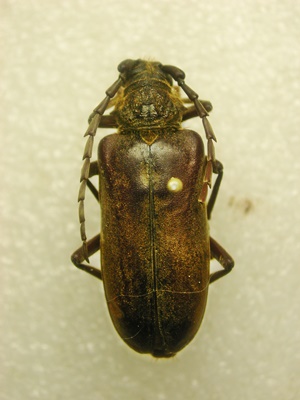| T O P I C R E V I E W |
| BillTyson |
Posted - 18/05/2015 : 23:51:15

39.06áKB
RSA, Mt. Helderberg, December, 30 mm
Perhaps this will help, even though fuzzy.

27.43áKB |
| 13 L A T E S T R E P L I E S (Newest First) |
| Francesco |
Posted - 20/05/2015 : 21:26:34
Ho paura che non siano precise sulle femmine. |
| Carlo |
Posted - 20/05/2015 : 21:24:07
Con le tabelle di Adlbauer non ci si arriva? |
| Francesco |
Posted - 20/05/2015 : 21:13:26
I am uncertain between Prosphilus pectinicornis Veiga Ferreira, 1953 and P. serricornis (Dalman, 1817)
Both are present in South Africa. |
| Pierre |
Posted - 20/05/2015 : 16:47:09
oui, effectivement, la femelle Prosphilus est tout Ó fait plausible. |
| Carlo |
Posted - 20/05/2015 : 16:05:26
Francesco credo che tu abbia ragione 

82.92 KB |
| Francesco |
Posted - 20/05/2015 : 10:29:06
quote:
Originally posted by Pierre
They tend to show flattened elongate antennal joints. Now what is flabellate, and what is not...
True; however, body larger, antennae shorter, pronotum with "strange" sculpturing", V antennomere flabellate and not spined, etc. suggest that it is a female of Prosphilus, as this one. |
| Pierre |
Posted - 20/05/2015 : 10:19:19
Well, when I think of things like these
http://www.cerambycoidea.com/forum/topic.asp?TOPIC_ID=1961
http://www.cerambycoidea.com/forum/topic.asp?TOPIC_ID=2341
http://www.cerambycoidea.com/forum/topic.asp?TOPIC_ID=17903
http://www.cerambycoidea.com/forum/topic.asp?TOPIC_ID=17794
http://www.cerambycoidea.com/forum/topic.asp?TOPIC_ID=14437
http://www.cerambycoidea.com/forum/topic.asp?TOPIC_ID=3199
etc.
They tend to show flattened elongate antennal joints. Now what is flabellate, and what is not... |
| Francesco |
Posted - 20/05/2015 : 09:48:46
No Neoplocaederus-species shows flabellate antennae... |
| Pierre |
Posted - 20/05/2015 : 09:15:31
I may be completely out of topic but... the insertion of the antennae has the typical Neoplocaederus-look. I also see spines on the sides of the pronotum. A good vertical sight on pronotum & head could be helpful. |
| Francesco |
Posted - 20/05/2015 : 08:36:07
I'd look for Prosphilus... |
| BillTyson |
Posted - 20/05/2015 : 00:44:28
I did not collect it so the data may not be good.
I have T. brevipennis and will compare it.
thanks |
| Carlo |
Posted - 19/05/2015 : 20:11:37
.... but brevipennis is not from RSA |
| Carlo |
Posted - 19/05/2015 : 20:07:16
Maybe Taurotagus.... maybe maybe brevipennis |


